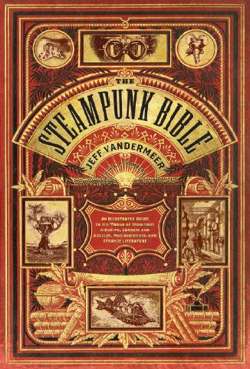Since the official release of my and Jeff Vandermeer’s The Steampunk Bible in May in Austin, I’ve been on tour throughout New England promoting the book, meeting many of the people who we featured in the book, and falling in love with the steampunk community as a whole.
The second leg of my tour for The Steampunk Bible was completed earlier this month and proved to be every bit of a positive experience as the first leg, which can be caught up on here.
May 28-30, Philadelphia and Claymont, DE
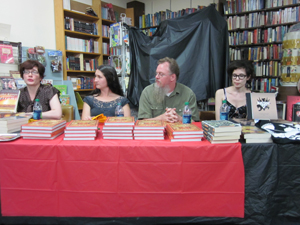 Between Books would be the last event in which I was accompanied by contributors, and the first to feature music. It was great to sit beside Ekaterina Sedia and Aleks Sennwald again, and for this panel I asked Edward “Philly Poe Guy” Pettit to moderate a discussion about the book’s process, steampunk origins, and what the label “steampunk” means. We were a small panel in proportion to how large the audience was, and it wasn’t before long the evening turned into a store-wide conversation.
Between Books would be the last event in which I was accompanied by contributors, and the first to feature music. It was great to sit beside Ekaterina Sedia and Aleks Sennwald again, and for this panel I asked Edward “Philly Poe Guy” Pettit to moderate a discussion about the book’s process, steampunk origins, and what the label “steampunk” means. We were a small panel in proportion to how large the audience was, and it wasn’t before long the evening turned into a store-wide conversation.
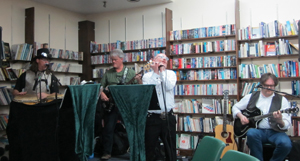 Following that and signings, local Philadelphia steampunk band The Absinthe Drinkers took the stage and filled the store with great tunes with lyrics adapted from classical literature, including Shakespeare, Baudelaire, and Poe. While the band played, a Steampunk Bible cake was cut and served, and I perused Greg Schauer’s phenomenonal store that has one of the largest and diverse selection of SF books and comics I’ve seen. Schauer is also a really great guy to talk too, and I had a lovely time talking books with him. I can’t thank him enough for going all out and letting us crash the store and to do this fun event.
Following that and signings, local Philadelphia steampunk band The Absinthe Drinkers took the stage and filled the store with great tunes with lyrics adapted from classical literature, including Shakespeare, Baudelaire, and Poe. While the band played, a Steampunk Bible cake was cut and served, and I perused Greg Schauer’s phenomenonal store that has one of the largest and diverse selection of SF books and comics I’ve seen. Schauer is also a really great guy to talk too, and I had a lovely time talking books with him. I can’t thank him enough for going all out and letting us crash the store and to do this fun event.
The next day, Sennwald, Paws cartoonist Pete Toms, and I met up with Philly-bound Strange Horizons editor Dave Nagdeman, who took us on a whirlwind but pleasant tour of The City of Brotherly Love. The main highlight was a visit to the Poe House, and a cross-city walking tour taking in the architecture of the historical district near Penn’s Landing. We only had one full day in Philly, and on Memorial Day itself, for the first time of the whole tour Sennwald and I parted ways. She and Toms returned to New York, and I began my descent southward to D. C.
May 31, Library of Congress, Washington, D. C.
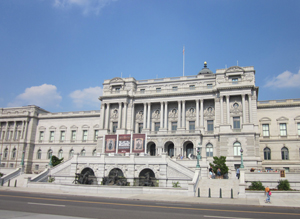 On Tuesday afternoon, May 31st, I had the honor of speaking before the Library of Congress staff as part of their “What If
Science Fiction & Fantasy Forum” series. I gave a half hour lecture on “Edgar Allan Poe: The Founding Father of SF.” This lecture was a product of my work over the last seven years in which I attempted to bring awareness of Poe’s vast influence upon fantasy and science fiction, in addition to the more popularly known influence in horror and mystery. Pieces of it have been scattered around various publications, including this one, but this was the first time the entire big picture was presented, and it was really well received.
On Tuesday afternoon, May 31st, I had the honor of speaking before the Library of Congress staff as part of their “What If
Science Fiction & Fantasy Forum” series. I gave a half hour lecture on “Edgar Allan Poe: The Founding Father of SF.” This lecture was a product of my work over the last seven years in which I attempted to bring awareness of Poe’s vast influence upon fantasy and science fiction, in addition to the more popularly known influence in horror and mystery. Pieces of it have been scattered around various publications, including this one, but this was the first time the entire big picture was presented, and it was really well received.
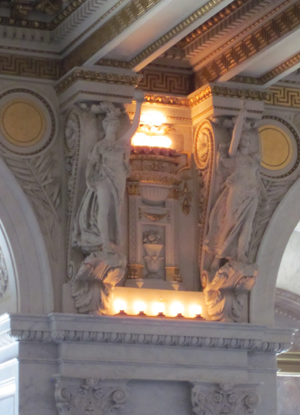 Afterwards, I was treated to a lovely lunch with the program’s lead coordinator Helen Hester-Ossa, her husband and Poe enthusiast Eugene Ossa, and LoC’s Associate General Counsel Hope O’Keefe. Afterwards, Ms. O’Keefe gave me an exclusive tour of that temple of American literacy, the Jefferson building. Not only is the architecture and painting phenomenonal, but beneath all the ornamentation is a secret history of the U.S. trying to demonstrate its power among not only industry, but the intellectual frontier. Within the building are majestic marble columns, fresco murals by some of America’s premier Gilded Age painters, sculpture showcasing the mysteries of electricity (it was the first building in D.C. to be wired), and all throughout are Sistine Chapel-like nods to international writers of all stripes, from natural philosophers like Newton, to the Greek poetess Sappho (the only woman who gets a nod in the entire building).
Afterwards, I was treated to a lovely lunch with the program’s lead coordinator Helen Hester-Ossa, her husband and Poe enthusiast Eugene Ossa, and LoC’s Associate General Counsel Hope O’Keefe. Afterwards, Ms. O’Keefe gave me an exclusive tour of that temple of American literacy, the Jefferson building. Not only is the architecture and painting phenomenonal, but beneath all the ornamentation is a secret history of the U.S. trying to demonstrate its power among not only industry, but the intellectual frontier. Within the building are majestic marble columns, fresco murals by some of America’s premier Gilded Age painters, sculpture showcasing the mysteries of electricity (it was the first building in D.C. to be wired), and all throughout are Sistine Chapel-like nods to international writers of all stripes, from natural philosophers like Newton, to the Greek poetess Sappho (the only woman who gets a nod in the entire building).
Underneath all this historical art and allegory, the Library also had installed several computer stations that allowed visitor’s to interact with the museum more intimately. For instance, the Library is in possession of a complete Gutenberg Bible, which is on display, but only two pages are viewable, which are occassionally turned by staff. However, the computer station allows you to peruse a digital version, and you can get a transcendental impression by seeing the techniques (like colored and embellished font) that the new press used to replicate and eradicate the Illuminated manuscript.
They had a similar set-up in the Jefferson Collection exhibit, where after drooling over replicated bookshelves, visitors can select from all the titles and flip through early (digitally scanned) editions of Buffon. From a “future of the book” aspect, it was pretty interesting to have every biblio-revolution to date under one roof, and a bit disturbing when you began to imagine exhibits a century from now, where perhaps the e-book will stand triumphant over Gutenberg and all his printed progeny.
June 2, Fountain Books, Richmond, VA
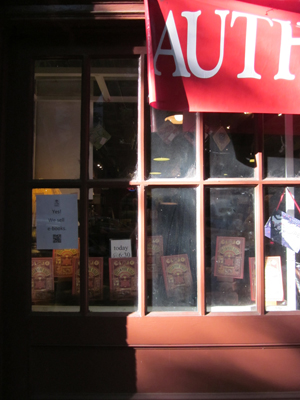 However, my doubts were soon quelled when I arrived at Kelly Justice’s Fountain Bookstore in Richmond. On this tour, I was amazed by every bookstore I visited, especially appreciating how each branched away from a common bibliophilic passion to grow its own unique personality and book culture brand. Fountain Books was no exception, and if anything, it finally drove home something that had been slowly dawning on me the entire fortnight: the tradition of bookselling is not dead. Even when being confronted with those digital harbingers in the Library of Congress, the tradition is alive and well, and as long as there are Greg Schauers and Kelly Justice’s in the world still giving a damn about books, it’ll stay alive.
However, my doubts were soon quelled when I arrived at Kelly Justice’s Fountain Bookstore in Richmond. On this tour, I was amazed by every bookstore I visited, especially appreciating how each branched away from a common bibliophilic passion to grow its own unique personality and book culture brand. Fountain Books was no exception, and if anything, it finally drove home something that had been slowly dawning on me the entire fortnight: the tradition of bookselling is not dead. Even when being confronted with those digital harbingers in the Library of Congress, the tradition is alive and well, and as long as there are Greg Schauers and Kelly Justice’s in the world still giving a damn about books, it’ll stay alive.
For many readers this may be a Captain Obvious statement, but in my hometown—a state capital and home of two major universities—there is nothing like Fountain, Between Books, or Porter Square. We have three major book chains, but none do much in the way of bringing in authors. When an author does come into town, its through the University, and as great as they are, it is usually held at a large venue ill equipped for conversations and actual idea exchange. So what I’m ranting about is I realized my town wasn’t Indiebound, and that that was what it, and I, were lacking in life. So, if you have the great fortune to live in a town with an Independent bookstore, go visit, buy books from them, and most of all appreciate a place that works extra hard to keep book culture alive.
Off of my soapbox now and back to the event, there was a great turnout. I want to thank Kelly Justice and Fountain bookseller Doc Gillespie for being so smart and awesome, the audience who came out, including local author Lenore Hart (The Raven’s Bride), who brought with her some lovely and very steam-stylish friends.
Post-event, I did more marathon exploring. Richmond was where my man Poe grew up, and I was thrilled to have friend and esteemed Poe scholar, Dr. Harry Lee Poe, show me around the Poe Museum (which is a must-see on any Richmond trip) and also the city itself as Poe would have known it. I visited the graves of the author’s mother, foster parents, and childhood friends, including Jane Standard, who was the inspiration for the first “To Helen.”
On another day, friend and fellow scribe J. T. Glover showed me another historical aspect of Richmond by taking me to the Hollywood Cemetery, the final resting place of fantasist James Branch Cabell, among other famous men and women, and which overlooks the James River. It was a beautiful view, and the dead don’t know what they’re missing. And on that note, that was how the tour ended, and how I think it could be described overall: the views were beautiful and filled with good company.
Thanks to Tor.com and Tor.com Steampunk for indulging me in these dispatches. Double thanks to the readers and those who came out, and to those who helped spread the word during these events.
For those curious about the further happenings of the book, including my European tour in September, and the long-awaited premier of The Steampunk Bible Index, please check out the book’s website.
S. J. Chambers is co-author of The Steampunk Bible (Abrams Image), to which she has been touring for since its release May 1st. She is also the Articles Senior editor for Strange Horizons magazine, and a contributor to Bookslut.










